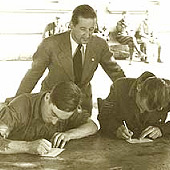|
|
|
 |
|
|
|
|
 |
Gives Up Work as a Surgeon, Heads to the Spanish Civil War
In May 1936 the Italians occupied the Ethiopian capital of Addis Ababa, and the Second Italo-Abyssinian War came to an end. Dr. Junod, then 32, returned to Geneva, but it was only to be for a short time. Two months later civil war broke out in Spain.
|
At a meeting of the ICRC in Geneva, Max Huber, the committee's president, declared, "All postal communication with Spain has been cut. We must do something. The Red Cross cannot remain indifferent when men, women and children are in need of assistance anywhere in the world. We must find someone to go there as quickly as possible and find out what can be done." All eyes turned to Dr. Junod, who was planning to return to his work as a surgeon in Mulhouse. No one imagined that his assignment, originally intended to last three weeks at the most, would last three years.
At the time, the Geneva Convention applied only to wars between nations and not to civil wars like that being fought in Spain. However, Dr. Junod worked hard to improve the treatment of prisoners from a humanitarian standpoint and to carry out prisoner exchanges. As a result, during the fierce battle just before the fall of Barcelona he was able to save the lives of several thousand condemned prisoners.
During the Spanish Civil War Dr. Junod not only provided care for those who were injured but also created the "Red Cross card system" by which communications between prisoners and their families took place. Prisoners wrote their names, addresses, and messages of 25 words or less on small cards, which served as evidence that they were alive. Many people wept with joy upon read the name and seeing the signature on the card, knowing that their loved one was alive. Dr. Junod succeeded in giving families hope. More than 5 million of these "cards of hope" served as links between family members.
Based on these cards, the ICRC later ran a system that functioned as a sort of "giant bulletin board" for tens of thousands of missing persons and their families by which postcards were sent to the Red Cross in Geneva. When postcards from two people came together in the same file, contact was reestablished between the prisoners and their families. This system eased the distress of family members who could not contact prisoners and the anxiety of the prisoners themselves.
|
|
|
|
|